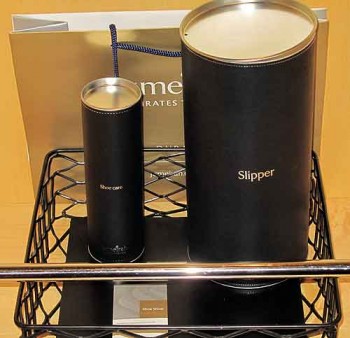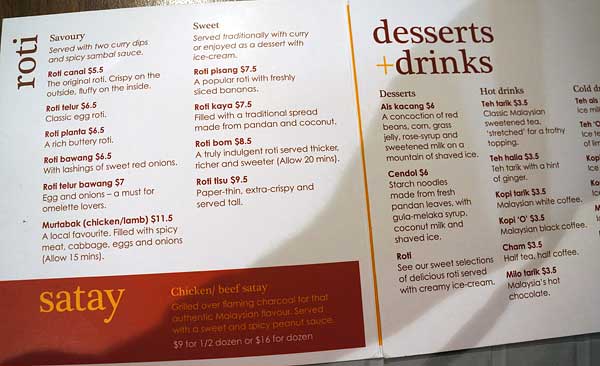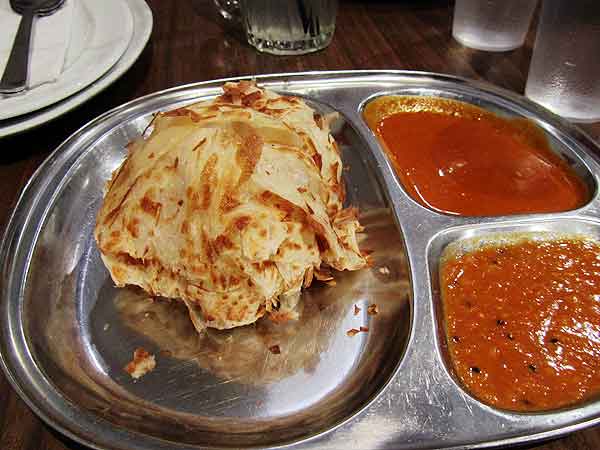Framed and accused of theft
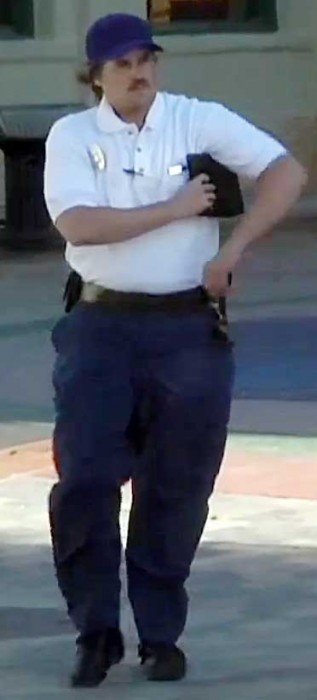
In what could be called a social experiment, it is proven that a man in a police-like uniform has great power and ordinary citizens are easily bamboozled into idiotic obedience. When the intent is robbery, pseudo-cops usually rely on flashing a fake badge; compliant victims then hand over their wallets.
In the following cases, “pseudo-cops” detain and accuse innocent passersby of theft. Watch the accused squirm under interrogation and threats; remarkably, they never question the legitimacy of the uniformed authority.
Bob Arno, preeminent pickpocket, was asked to help make a commercial for Toshiba and Intel. The idea was to slip the company’s new laptop into the bags of unsuspecting people as they strolled through Culver City, California. The laptop, called “UltraBook,” is so thin and light, the company believed that no one would even notice.
Preposterous! It turned out to be a challenging assignment.
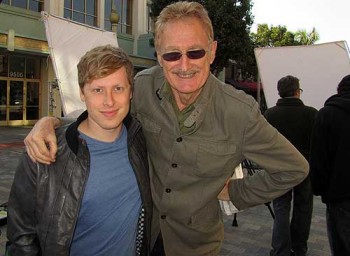
Bob roped in the talented and adorable magician Ben Seidman and together, the two deceivers rehearsed the teamwork and choreography necessary to “put-pocket” the computer.
Now, a computer, no matter how light, is a noticeable weight factor when added to a tote someone is carrying. And it is of a size that is difficult to slip in, between straps, handles, zippers, and buckles. It took some doing to distract the victim and mask the PLUNK! of the extra weight dropping in.
In practice, the two sneaks were more than successful. After brief, seemingly innocent encounters, more than a dozen unsuspecting victims wandered the streets unknowingly toting a Toshiba UltraBook.
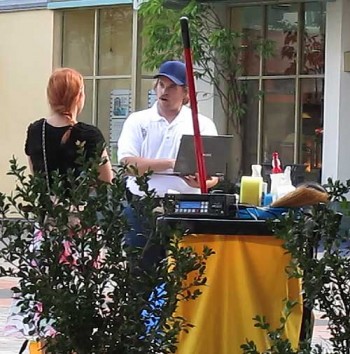
Each victim was then questioned by a “security guard” about a laptop which had supposedly been reported stolen. After a polite request to search the victim’s bag, the shocking discovery of the “stolen” laptop, and the victim’s protestations of innocence, the pseudo-cop became rude, belligerent, and provocative.
“For a criminal, you’ve got excellent taste,” the security guard said while admiring the laptop.
“You’re going to jail, missy!” the bad cop threatened one poor victim.
“Your fingerprints are all over it,” the guard told another victim after making him feel the weight of the laptop.
“But you told me to hold it!” the vic protested.
“We have no record of that,” the guard said.
To victim Claudia the guard says “You have great taste in stealing products.”
“Thank you,” Claudia replies, stunned almost speechless.
“What else do you have that’s stolen?” the guard demands.
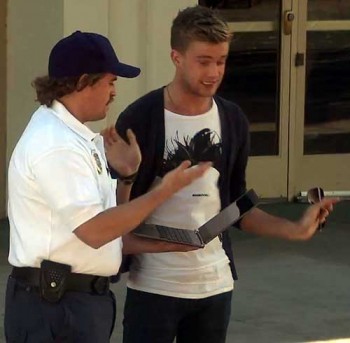
One victim broke down and cried. Another ran away. One accused the guard of racial profiling. But most stood in compliant disbelief.
The video series is a fantastic study of human behavior. It’s amazing to see how obedient people are when ordered around by an actor in a bad uniform. They’re blinded by authority. Most victims obeyed even his most ridiculous commands.
Watch Claudia’s frightened confusion:
Check out Ryan’s reaction:
http://www.youtube.com/watch?v=2l5-ul-Z0kA
See Tiffany’s disbelief:
http://www.youtube.com/watch?v=EV_nCLykZ_w
Here’s a montage of many victims:
http://www.youtube.com/watch?v=yoGYjtCo350
And meet the pickpockets who did the job:
http://www.youtube.com/watch?v=D49VH2Fav_4
The video ads were directed by Michael Addis and Jamie Kennedy. Though the experience was briefly brutal and sometimes frightening to the victims, comic relief was brought into each scene at the last minute, and some of the victims were rewarded with the gift of a laptop.
In the real world, thieves take advantage of our engrained respect for authority when they play pseudo-cop. With nothing more than a fake badge and a flimsy story, they make demands similar to our actor’s: open your bag, let me look inside, give me your wallet, give me your money… etc. We tend not to question them; we are obedient. And only later do we realize our gullibility. The thieves exploit our respect for authority and take advantage of our trust—that’s the CONfidence-building that gives the con artist his title.
Heist height help
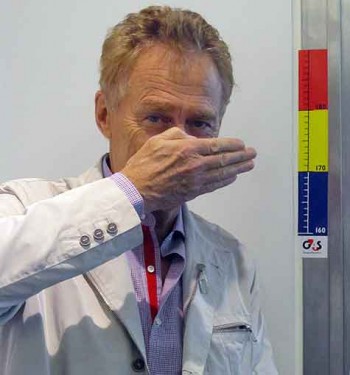
I’ve never noticed these height-markers before, but I’m told they’re found everywhere. I saw this one in a bank in Stockholm last summer. Pasted on the inside of the door frame, it helps estimate the height of the fleeing robber caught on video. I still haven’t spotted another one, even though I’ve been on the lookout. Have you seen any?
Perps’ anti-arrest tactic
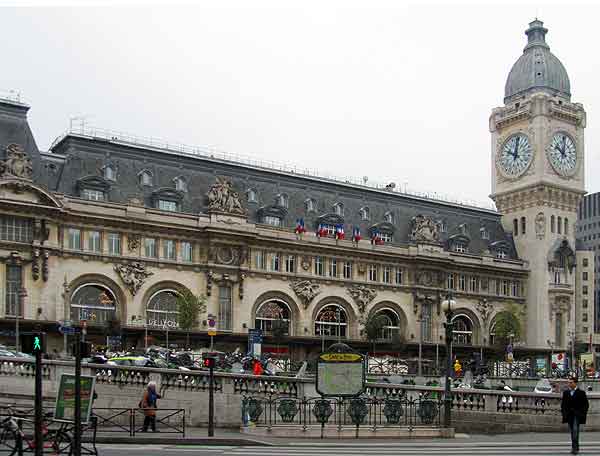
Press the play button:
Awful sound, isn’t it? Sorry to subject you (if it autoplayed in your browser), but I’m making a point.
This racket was blasting when Bob and I visited the Gare de Lyon police station in Paris. It was created by two young women, one in a cell, the other handcuffed to a wooden bench, where she posed in every ridiculous posture she could contort herself into (not sure why). They both bellowed and sang at the top of their lungs as long as we were there—perhaps half an hour—possibly much longer.
It’s their habit. They make themselves severely unwanted guests, so the police think twice about hauling them in again and again. We never found out what they were arrested for, but their tactic was arresting.
The yelling and wailing in jail is one of the cat-and-mouse games the criminals learn to play to get an advantage, even a momentary tiny one, over the system. You know some of their other strategies: they employ children too young to arrest; they carry an infant, because the mother of an infant won’t be jailed; they cut themselves, because a bleeding arrestee must be taken to the hospital, which takes much paperwork that a tired cop may prefer to avoid, especially one near the end of his shift.
A pickpocket in Lima told us, “If the police catch you, you cut yourself and they release you. They don’t want you if you’re cut and bleeding.”
Bob Arno interview on Huffington Post
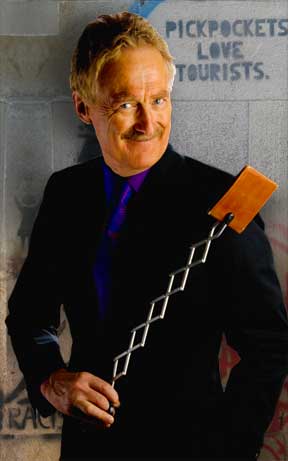
Huffington Post picked up an interview of Bob Arno from over on JustLuxe.com a few days ago. Here’s a reprint of the question and answers:
Among women who carry a purse or handbag, which ones are safest? How do you position the strap? What’s the worst mistake you see in how they hold and look after the bag?
Bob Arno: The worst, and the most common mistake, is to hang your handbag on back of the chair, or to tuck the bag behind you on the seat. You think you have physical contact with the bag, but fifteen minutes into the meal you forget! I’ve seen surveillance videos in which a gang of three thieves in a well-established luxury hotel restaurant position themselves strategically around a targeted breakfast table, talking to each other on their cell phones. They wait for the perfect moment when the owner of the bag — the victim — leans forward. At that moment, the controller of the gang gives a small hand signal to the other two to execute their independent moves so that everything is coordinated. One accomplice creates a small diversion in front of the table, and the other observes the restaurant staff, to be sure nobody pays attention to the incident. The thief unrolls a soft jacket from his fanny-pack and drapes it over his arm, allowing the fabric to come down over the victim’s handbag. He scoops up the bag under the cover of the nylon jacket. They then immediately leave the restaurant. Coffee shops (such as Starbucks and their competitors) are extremely popular venues for thieves who practice bag stealing.
Conclusion: You must have your purse in front of you and keep physical contact when traveling. If it is a purse with long strap, wear it in front of your body when you are in a vulnerable location or environment.
What’s the safest place for a man to carry his wallet?
BA: Men should carry their wallets in their tightest pocket. Still, that’s not always safe enough. For added security, men might try one of four kinds of under-clothes pouches which are comfortable and functional for easy access, but which make it almost impossible for thieves to steal from.
-
- 1. A pouch that hangs from a string around your neck and is worn under your shirt.
2. A pouch that hangs from your belt by a loop and is worn inside your pants.
3. Ankle-holsters in various designs and levels of sophistication.
4. Underclothing with built-in pockets for valuables. One new product is called Stashitware. Another line is made by Clever Travel Companion.
What’s the best way to respond to aggressive panhandlers, who may or may not be pickpockets?
BA: We’re programmed to be polite to strangers who approach us, even in unfamiliar cities. It’s hard to be cynical or always suspicious. But it’s wise to question the motivation behind an encounter, regardless of how friendly the stranger appears to be. Scammers want to lull you into a false sense of security and then spring the “rope-in” move. I like to prescribe a dose of cynicism, though it’s not to everyone’s taste. In any case, aggression should not be rewarded with a handout. Step aside. Disengage.
Further to that, do gypsies actually exist? Where are they a threat?
BA: In terms of stealing and pickpocketing, they do represent a threat. But they are not always attempting to pickpocket when they simply beg. Young female pickpockets in Europe, age 13-18, often originate from East Europe and belong indirectly to gangs, controlled by organized crime bosses. These bosses travel across East European cities and “lease” young girls from their parents with promises of lofty employment in the service sector in Western Europe. They are then “processed” or tutored in various techniques of pickpocketing. Finally, after the “schooling” they are sent to cities like Paris or London, where they’re chaperoned daily by their controllers at lucrative “theft” locations, such as busy public transportation stations, maybe underground Metros or popular music festivals. These criminals are not violent and are more a nuisance than a serious threat, yet one has to have one’s guard up against them. They’re especially prevalent in the big cities of Western Europe and the United Kingdom.
What should one watch out for in a crowded market or bazaar?
BA: It’s always hard for law enforcement to patrol and observe everything that goes on in a big market. And the thieves are good at spotting undercover police officers. The good thing is that the merchants in popular markets and bazaars have their own security who alert shop owners about lurking pickpockets.
There are many exotic and bustling markets, for example the Grand Bazaar in Istanbul, which appear threatening, but which are in fact extremely safe. Perception can be wrong in either direction. Without listing every exciting bazaar around the world and ranking its safety, lets just say that common sense should rule. Don’t carry more cash than you are prepared to lose. Use those under-clothes pouches. Keep your purse or backpack in front of you (or leave it in the hotel). Markets, generally speaking, accept cash but not always credit cards, although even that is changing now with the abundance of new small portable wireless terminals.
What’s the best way to look after cameras, iPhones and other devices popular with petty thieves?
BA: A smart phone can easily be grabbed off your outdoor café table, with the culprit running (faster than you). I have never met a pickpocket who isn’t using a cell phone he or she previously stole from someone. Have a wide sturdy strap on your camera which is not easy to yank loose. Be sure it has strong clips at the end of the strap. For extreme situations, buy a camera case that actually has an opening in the bottom where the lens points down towards the opening. In other words, wear your equipment in disguised bags which do not have brand name logos on them, but rather something that will throw the thief off his target scent.
Important: Never fight a mugger! Cameras can be replaced, but getting a sharp object shoved into your body is not a good exchange. You cannot predict the behavior of a mugger. Pickpockets on the other hand are not prone to violence.
Please discuss hazards of public transportation.
BA: Public transport is by far the most common locale for pickpocketing. Especially during the moment you enter the tram/car/bus — or depart (at the door). The busier the Metro or the bus is, the higher the risk. Real professional teams travel in groups of three and create their own choke-points or blocking scenarios. Understanding that a large percentage of pickpocket thefts happen on or at public transportation should be enough to cause you to plan carefully and be on guard if the train or tram is crowded. It’s the physical jostling which needs to be avoided. But it’s also extremely easy to avoid the threat with a few obvious counter-moves. Just clasp your handbag solidly in front of you when entering; men can hold onto their wallets.
What are the biggest risks in using an ATM in an unfamiliar location?
BA: There are two threats tied to ATMs. One is the “skimmer,” a small device overlaying the mouth of the ATM (where you push in the bank or credit card). Skimmers can usually be spotted if one looks carefully at the ATM. If you recognize such a device, walk away and alert proper security personnel. Some skimmers are internal, and can’t be seen at all.
Two, and more ingenious, are “shoulder surfers.” They lurk near the ATMs and watch the PIN code used at the machine. When they get a PIN code, they watch where the credit card is put, then follow that person around, waiting for a good moment to steal the credit card.
Always shield your PIN as you enter it. Watch for lurkers, and use a different ATM if you’re suspicious of bystanders or the machine itself. If your card is “eaten” by the machine, try to cancel out of the transaction, even if you have to abandon your card. Do not accept help from a stranger in this situation.
— — — —
Lena Katz wrote the questions.
Hotel oddity #23

In the most staid of Dubai’s many elegant hotels, the most conservative and sedate, the Jumeriah Emirates Towers, provokes a little smile.
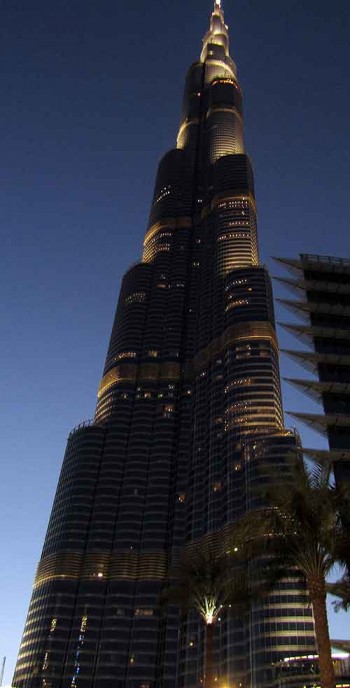

This after the awe of seeing Burj Kalifa right out our window, within waking distance. Unfortunately, Dubai is not a walking city. A long, convoluted taxi ride involving on-ramps, cloverleafs, and off-ramps was required to reach the block-away tower.
My favorite thing about Dubai: fabulous South Indian food. Second favorite thing: stunning architecture, fascinating by day, spectacularly lit by night. May as well mention my least favorite thing: giant malls. I don’t like any malls. The bigger the worse.
As we stood at our window wall gaping at the nearby Burj Kalifa, it slowly disappeared before our eyes. It was a dust storm, the likes of which I’ve never seen. The desert’s great magic trick.
Laughing in pidgin
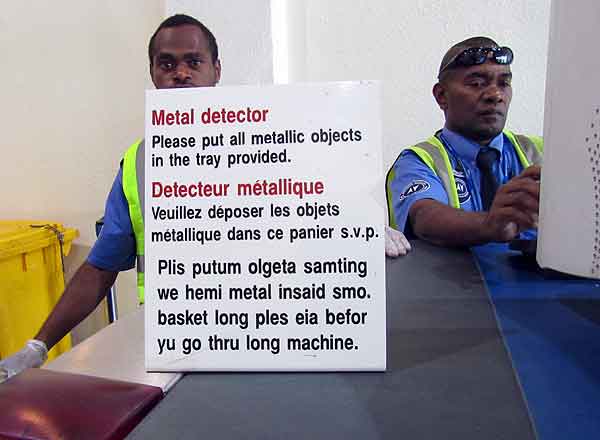


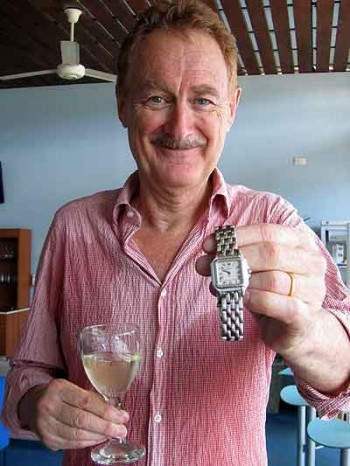
I was somewhere near the intersection of the equator and the international dateline when I saw this sign at airport security.
Plis putum algeta samting we hemi metal insaid smo basket long ples eia befor yu go thru long machine.
Just passing through Vila, in the Ripablik Blong Vanuatu, a volcanic archipelago nation independent since 1980 (before that, it was called The New Hebrides).
If you’ve ever collected stamps, as I did as a kid, your favorites were probably from Vanuatu. I remember ordering them: huge, gorgeous images of flora and fauna and, if I remember correctly, some odd-shaped stamps—I think diamond-shaped, or at least large squares on a 45-degree angle.
In the tiny airport lounge (difference: air conditioned) we were treated to banana chips and some other tasteless fried things. It was 10:00 a.m. but Bob and I toasted with sauvignon blanc from New Zealand, as we were in some other, unknown time zone.
When travel is not glamorous, it is, at least, amusing.
Travel. Glamorous?
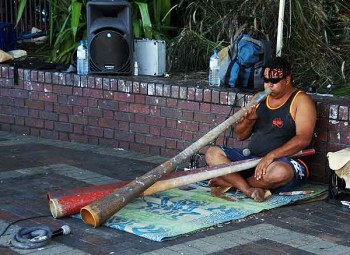
Contrast Mamak with our New Year’s day dinner at Appetito, also in Sydney. Recommended by two people, nearby—and most important: open—it seemed a reasonable choice, if not exciting.
The sourpuss staff seated us promptly, took our drink orders, and quickly brought our glasses of wine. From there on it was all downhill. Granted, we were tired, having slept only after the people in the room next to ours checked out—or were arrested—sometime after daylight broke.
Noisy parties might be expected on New Year’s eve, even in an airport hotel. But that’s not what went on at the Sydney Ibis. Its paper walls projected every groan, cry, and vulgarity uttered by our neighbors, and of course their fighting, shouting, wall-punching, and door-slamming. All night.
SLAM! “Get your ass back here, you fucking junkie!” Sob. Whack. SLAM!
The couple moved to the parking lot outside our windows, where they joined others for rollicking beer festivities laced with anger. We later learned the others were traveling companions staying in rooms on other floors.
There were sirens. Police. Ambulance. The woman “was hurting herself.”
Here’s the problem. The Sydney Ibis Airport hotel has no onsite security. It contracts with an outside company, but pays for each “house call.” The hotel’s night manager, who received nighttime complaints from many others in addition to us, was loathe to spring for an officer call and confronted the rowdy couple directly; and only much later called police.
So we may have been a bit cranky as we waited 40 minutes for our New Year’s day dinner. It was an appetizer of seafood frito misto and two pizzas—all quick items to prepare. They weren’t bad. Nothing special, either. Certainly not worth the $102 bill. The place left a bad aftertaste. There must have been many, many better choices.
Research is vital. So is a decent night’s sleep.
Travel: not always what it’s cracked up to be.
Mamak Malaysian restaurant, Sydney
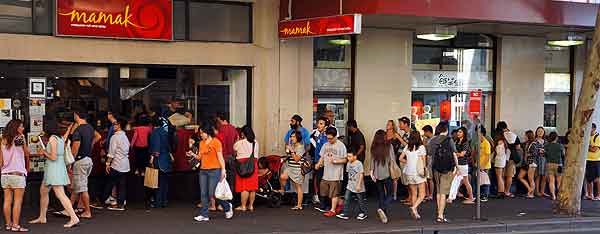
Mamak is worth standing in line for. Bob and I waited 50 minutes for what is actually rather ordinary Malaysian food. But you can’t get these dishes just anywhere, and here, they’re done to perfection. I’d call this restaurant perfect in every way my single visit allowed me to experience. Let’s start with the entertainment on offer…
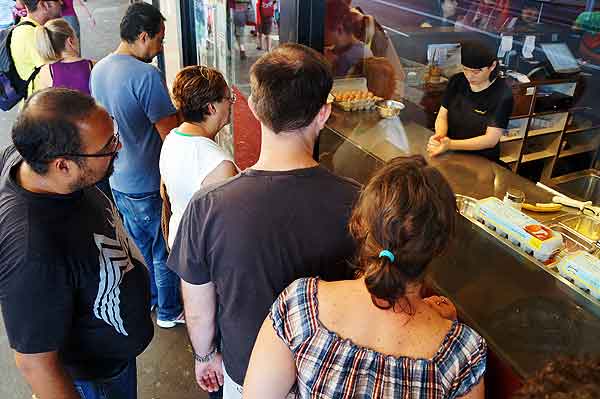
After standing in line for 30 or 40 minutes, you finally creep up to the glass wall of the kitchen. Two roti-makers work like machines at their stainless steel counter, stretching small balls of dough by flinging them over their heads until they look like giant, translucent handkerchiefs. You just know one is going to become a kite and sail onto the head of a grill cook. Or one will rip and fly into shreds. They never do. After the final toss, the dough lands on the counter stretched into the size of a sheet of newspaper.
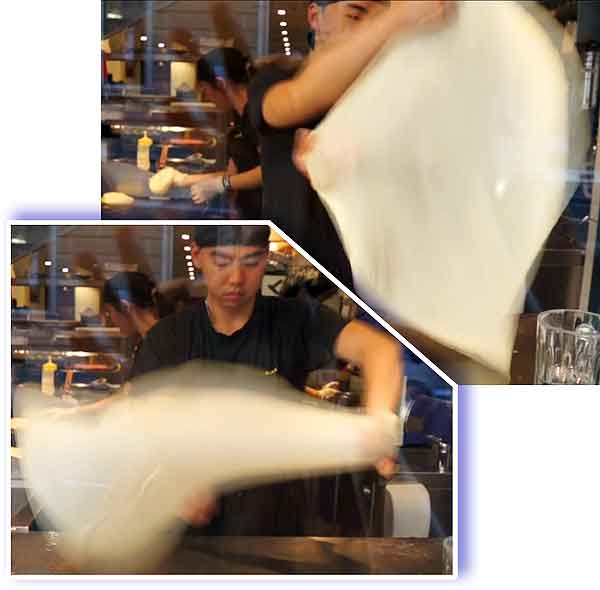
That’s when the roti is given it’s specific form. It might be quickly folded into an air-filled pillow and simply thrown on the grill, where cooks hover over the rotis, pressing them, flipping them, and rushing them off to drooling diners. Or the dough might first get a sprinkling of red onions. Bob and I ate rotis often when we lived in Singapore. In their most basic form, they’re simple flat breads served hot off the grill with a bowl of curry sauce for dipping.
A filled (and filling) version is called murtabak. An egg is broken onto the stretched dough, which is then topped with a smear of curry sauce, a toss of onion shreds, and possibly shredded chicken, mutton, or sardines. The gossamer dough is folded into a many-layered square, cooked on the grill, and served steaming hot with a bowl of spicy curry sauce. Perfection! Mamak serves murtabak. I wish I could have tried it, but we ordered other items.
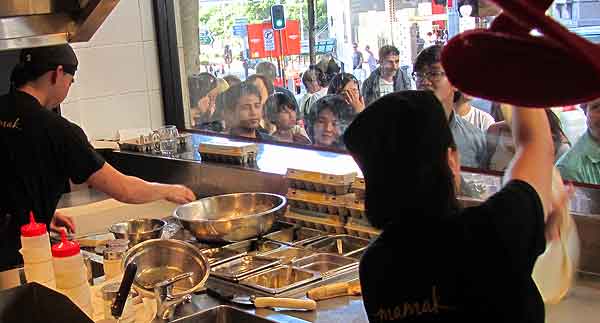
I’d gotten a menu to look at while in line, so we’d be ready to order right away. That’s the one tiny improvement that could speed Mamak’s turnover just a tad: menus outside so diner’s can use the waiting time to peruse the offerings.
When you finally enter the restaurant, all primed for a roti (but which one???), the fragrance of baking bread slays you. The urgency of the cooks and waiters increases your heart rate and your stomach announces its presence and desires. Luckily, Mamak is fast! Your order is in and out in moments.
Mamak cooks a small selection of Malaysian dishes (most of which are traditional street foods) which keeps the menu from overwhelming people unfamiliar with the cuisine. They do a variety of rotis, two kinds of satay, several curries and stir-fries, and spicy-fried chicken. There’s the classic nasi lemak, which is fragrant coconut rice with condiments (which we ordered), and a couple of fried noodle dishes.
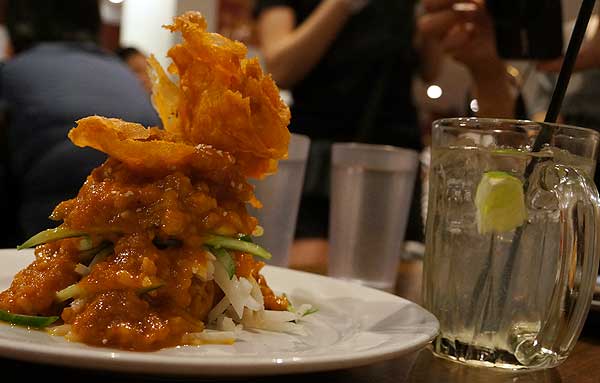
We also ordered rojak. I’ve had it many times in Singapore, but never like Mamak’s. Typically a salad of crisp and crunchy fruits and vegetables, julienned yambean and cucumber, fried tofu, and prawns, it’s coated with a spicy peanut sauce and garnished with hardboiled eggs. Mamak’s version was heavy on the sauce, sweet, tall, and… delicious.
Crisp and fluffy roti cania looked to be the most popular item on the menu. So simple, yet so satisfying. You lick your finger to pick up every last flake of the toasty bread.
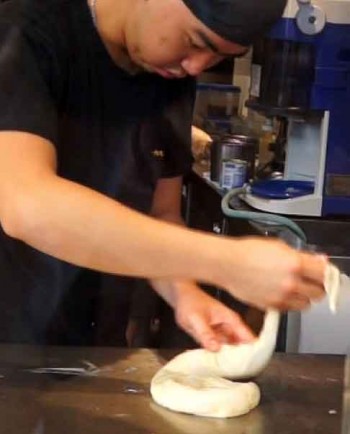
The rich and exotic roti planta requires a time-consuming process. Twenty or so little dabs of butter are spaced out along one edge of the stretched dough sheet. The sheet is then rolled into a lumpy, air-filled snake, the buttery dots along its length like undigested mice. The fragile tube is then carefully coiled like a sleek-skinned cobra, and set on the grill to crisp, melt, sizzle, and brown.
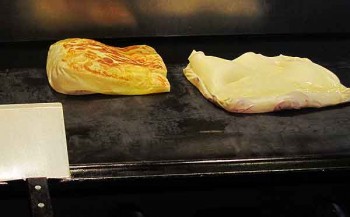
Mamak also offers a variety of Malaysian tea and coffee drinks, and two typical desserts: ice kachang and chendol. I ADORE chendol, a complicated ice dessert composed of many ingredients. Instead of trying it here though, Bob and I chose to go next door to the Taiwanese dessert shop called Meet Fresh. Yeah, funny name! I got “handmade taro-balls #4” with peanuts (soft), pearls, and red beans. I could have ordered it hot, but chose to have it over ice. Bob got mango sago coconut soup.
Taro-balls #4 was nice, but it’s no chendol. Come to think of it, chendol needs a post of its own. I dream of chendol, but only a certain kind. It must be topped with one particular fruit. I will tell you… soon!
In addition to the selection and quality of its food, Mamak gets a gold star for speed. Our meal arrived eight minutes after ordering it. When we left, the line was as long as when we got into it an hour and a half earlier. And guess what? After we finished dessert next door? Yep, the Mamak’s line was even longer.
On Goulburn at Dixon in Haymarket, on the edge of Sydney’s Chinatown, Mamak is a winner.
TV studios today
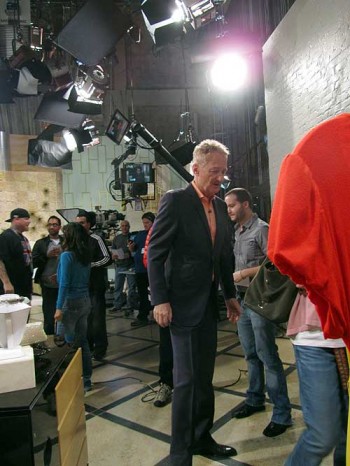
We did a lot of television these past few weeks, and I’m struck by the differences in studios and the effects on the interviews. The Access Hollywood studio in Burbank was full of bustling people: producers, hosts, camera operators, gaffers, powder-puffers, etc. The atmosphere was lively, jokey, fun, and efficient. Among the crew, there were winks, high-fives, and laughs, though within a sense of electric urgency: let’s get this done, but have a good time doing it.
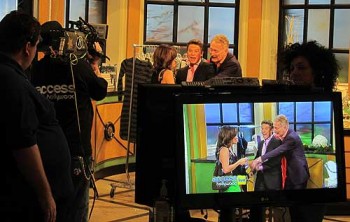
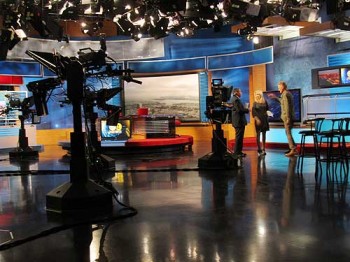
Contrast that with KCAL’s Studio City set at KCBS. The huge set was dark and completely empty of humans, except for the two hosts. Acres of polished cement were trod only by electronic cameras, which glided silently, each trailing a thick tail of bound cords. The atmosphere was…dead. The interview was humdrum. Uninspired. Perhaps there was a party going on in the control room, I don’t know.
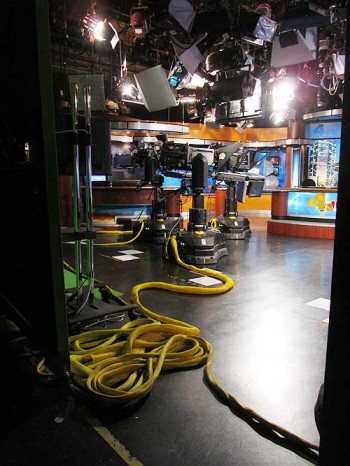
Same went for the KNBC Studio. Robotic cameras clicked and whirred in the darkness, rolling across the floor, rising, lowering, like ghost-spys. Their thick yellow umbilicals were, presumably, coiled by flesh-and-blood hands. Lack of human warmth leads to stilted talk, at least with a performer used to working in front of a live audience. The interview with Colleen Williams was interesting and informative, but dry.
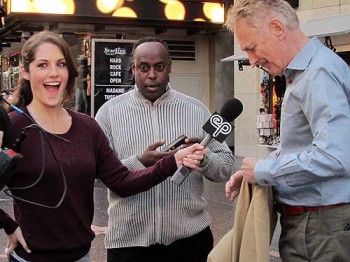
Understandably different were the streetside interviews. Electric Playground’s adorable Miri Jedeikin obviously had a blast interviewing Bob in the heart of Hollywood, and it shows in the finished product.
The Examiner‘s Danielle Turchiano and KABC-TV’s Ric Romero did lively sidewalk interviews in which Bob was able to demonstrate on passersby—always fun and successful.
In two trips to New York City, Bob appeared twice on Fox & Friends and once on The Today Show (which I can’t find online).
Yep, we’ve been busy.


